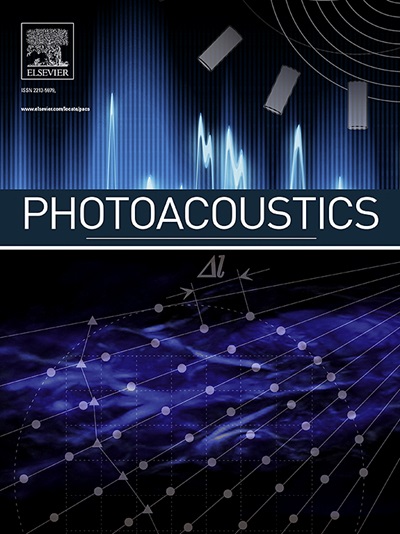基于声光共聚焦探针的光声和超声气管内窥镜用于表征慢性阻塞性肺疾病的幻影和模型
IF 6.8
1区 医学
Q1 ENGINEERING, BIOMEDICAL
引用次数: 0
摘要
光声内镜与超声内镜合一(PAE/EUS)是公认的检测肠道和血管内疾病的有效方法。气管形态和组成的变化是呼吸系统疾病的重要标志。在本研究中,声光共聚焦探头被开发并集成在直径2.1 mm的导管尖端,用于同时进行PAE/EUS成像。幻影实验结果表明,在激发能为1.5 μJ的情况下,该导管获得了11 µm的高横向分辨率,成像深度为12 mm。采用PAE/EUS系统对健康、慢性阻塞性肺疾病(COPD)兔模型和体内气管进行成像。结果表明,光声成像可以识别气管微血管直径和密度的增加,而超声成像可以提供气管粘膜下层的详细视图。这些发现强调了PAE/EUS在COPD诊断中的潜力。本文章由计算机程序翻译,如有差异,请以英文原文为准。
An acoustic-optic confocal probe based photoacoustic and ultrasonic tracheal endoscopy for characterizing phantom and model of chronic obstructive pulmonary disease
Integrated photoacoustic endoscopy and endoscopic ultrasound (PAE/EUS) are recognized as an effective method for detecting intestinal and intravascular diseases. Changes in the morphology and composition of the trachea are significant hallmarks of respiratory diseases. In this study, an acoustic-optic confocal probe was developed and integrated at the tip of a 2.1 mm diameter catheter to perform simultaneous PAE/EUS imaging. Phantom experimental results demonstrated that the catheter achieved a high lateral resolution of 11 µm, with an imaging depth of 12 mm, using an excitation energy of 1.5 μJ. Trachea from healthy and chronic obstructive pulmonary disease (COPD) rabbit models and in vivo were imaged by the PAE/EUS system. The results demonstrated that photoacoustic imaging could identify increases in the diameter and density of the tracheal microvessels, while ultrasound imaging provided detailed views of the tracheal submucosa. These findings underscore the potential of PAE/EUS in the diagnosis of COPD.
求助全文
通过发布文献求助,成功后即可免费获取论文全文。
去求助
来源期刊

Photoacoustics
Physics and Astronomy-Atomic and Molecular Physics, and Optics
CiteScore
11.40
自引率
16.50%
发文量
96
审稿时长
53 days
期刊介绍:
The open access Photoacoustics journal (PACS) aims to publish original research and review contributions in the field of photoacoustics-optoacoustics-thermoacoustics. This field utilizes acoustical and ultrasonic phenomena excited by electromagnetic radiation for the detection, visualization, and characterization of various materials and biological tissues, including living organisms.
Recent advancements in laser technologies, ultrasound detection approaches, inverse theory, and fast reconstruction algorithms have greatly supported the rapid progress in this field. The unique contrast provided by molecular absorption in photoacoustic-optoacoustic-thermoacoustic methods has allowed for addressing unmet biological and medical needs such as pre-clinical research, clinical imaging of vasculature, tissue and disease physiology, drug efficacy, surgery guidance, and therapy monitoring.
Applications of this field encompass a wide range of medical imaging and sensing applications, including cancer, vascular diseases, brain neurophysiology, ophthalmology, and diabetes. Moreover, photoacoustics-optoacoustics-thermoacoustics is a multidisciplinary field, with contributions from chemistry and nanotechnology, where novel materials such as biodegradable nanoparticles, organic dyes, targeted agents, theranostic probes, and genetically expressed markers are being actively developed.
These advanced materials have significantly improved the signal-to-noise ratio and tissue contrast in photoacoustic methods.
 求助内容:
求助内容: 应助结果提醒方式:
应助结果提醒方式:


